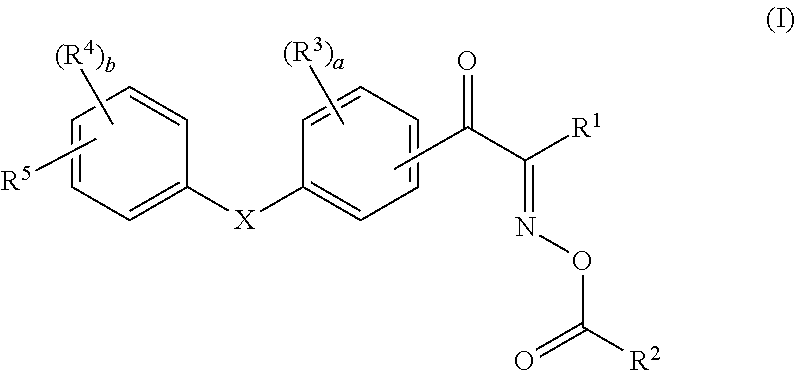Oxime ester compound and photopolymerization initiator containing the same
- Summary
- Abstract
- Description
- Claims
- Application Information
AI Technical Summary
Benefits of technology
Problems solved by technology
Method used
Image
Examples
example 1
[0149]Production of Compound No. 2
[0150]Step 1: Acylation
[0151]To a solution containing 92 g of dichioroethane and 21.7 g (163 mmol) of aluminum chloride was added 15 g (65 mmol) of 4-(phenylthio)benzoic acid, and then 9.0 g (97 mmol) of propionyl chloride was dropped thereto at a temperature of 6° C. or below. After stirring for 1 hour, the reaction solution was poured into ice water and then ethyl acetate was added thereto to separate it into the oil and aqueous phases, and the organic layer was washed with water. The organic layer was dried with anhydrous magnesium sulfate and then the solvent was removed, to yield 18.7 g of acylated compound a.
[0152]Step 2: Oximation
[0153]To a solution containing 10.0 g (35 mmol) of the acylated compound a obtained in Step 1 above, 3.6 g (35 mmol) of concentrated hydrochloric acid, and 30 g of dimethylformamide was added 5.4 g (52 mmol) of isobutyl nitrite, and the mixture was stirred for 3.5 hours at room temperature. After stirring, ethyl acet...
examples 2 to 4
[0156]Production of Compounds Nos. 26 and 44 to 46
[0157]Compounds Nos. 26 and 44 to 46 of the present invention were produced from respectively-corresponding ketones according to the method described in Example 1. Analyses results thereof are shown in Tables 1 to 3.
TABLE 1MeltingOxime Esterλ max*1PointDecompositionCompound(nm)(° C.)Point (° C.)Example 1Compound No. 2291, 335151181Example 2Compound No. 2633596202Example 3Compound No. 44334100140Example 4Compound No. 45292, 33556225Example 5Compound No. 46336130143*1The solvent used was CHCl3.
TABLE 2OximeEsterCompoundIR Absorption Spectra (cm−1)Example 1Compound2980, 2838, 2672, 2559, 1782, 1688,No. 21670, 1596, 1586, 1563, 1424, 1368, 1317, 1293, 1214, 1177, 1085, 994, 944, 905, 881,757Example 2Compound3529, 2937, 1782, 1652, 1596, 1581, 1491,No. 261364, 1300, 1329, 1253, 1217, 1173, 1191,1083, 946, 908, 824, 746, 536Example 3Compound3065, 1770, 1712, 1664, 1587, 1552, 1493,No. 441437, 1404, 1367, 1323, 1215, 1178, 1083,996, 944, 884...
example 6
[0158]Production of Alkali-Developable Photosensitive Resin Composition No. 1
[0159]Step 1: Production of Alkali-Developable Resin
[0160]In a reaction vessel were placed 184 g of bisphenol fluorene epoxy resin (epoxy equivalent: 231), 58 g of acrylic acid, 0.26 g of 2,6-di-tert-butyl-p-cresol, 0.11 g of tetra-n-butylammonium bromide, and 23 g of propylene glycol-1-monomethyl ether-2-acetate, and the mixture was stirred for 16 hours at 120° C. The reaction solution was cooled to room temperature, and thereafter, 35 g of propylene glycol-1-monomethyl ether-2-acetate, 59 g of biphthalic anhydride, and 0.24 g of tetra-n-butylammonium bromide were added thereto and the mixture was stirred for 4 hours at 120° C. After stirring for 4 hours, 20 g of tetrahydrophthalic anhydride was added thereto, and the mixture was stirred for 4 hours at 120° C., for 3 hours at 100° C., for 4 hours at 80° C., for 6 hours at 60° C., and for 11 hours at 40° C. After stirring, 90 g of propylene glycol-1-monomet...
PUM
| Property | Measurement | Unit |
|---|---|---|
| Nanoscale particle size | aaaaa | aaaaa |
| Temperature | aaaaa | aaaaa |
| Temperature | aaaaa | aaaaa |
Abstract
Description
Claims
Application Information
 Login to View More
Login to View More - R&D
- Intellectual Property
- Life Sciences
- Materials
- Tech Scout
- Unparalleled Data Quality
- Higher Quality Content
- 60% Fewer Hallucinations
Browse by: Latest US Patents, China's latest patents, Technical Efficacy Thesaurus, Application Domain, Technology Topic, Popular Technical Reports.
© 2025 PatSnap. All rights reserved.Legal|Privacy policy|Modern Slavery Act Transparency Statement|Sitemap|About US| Contact US: help@patsnap.com



